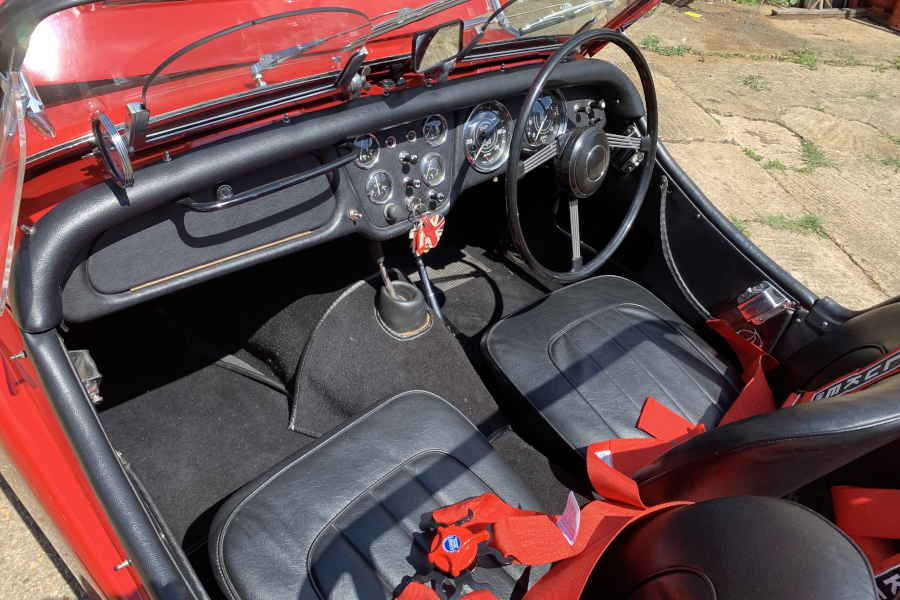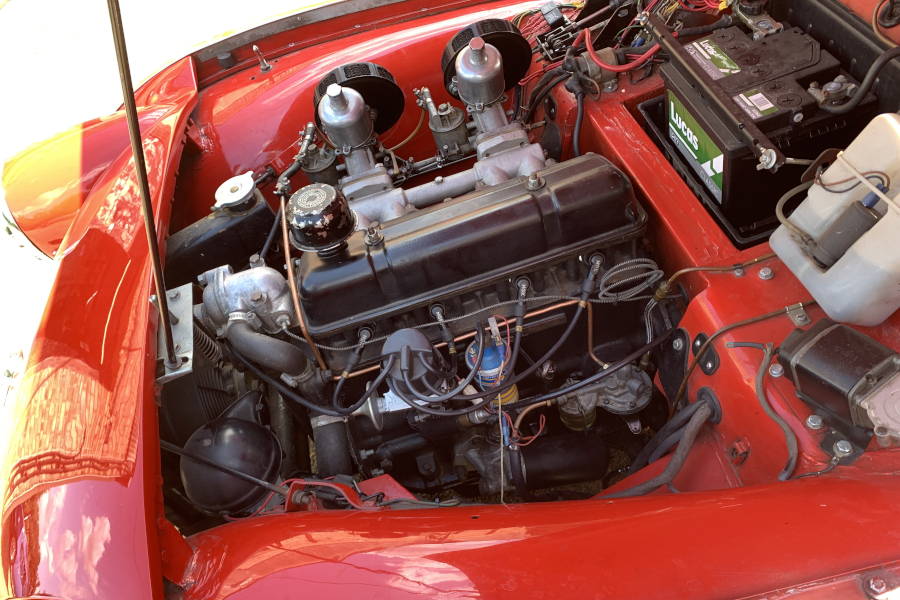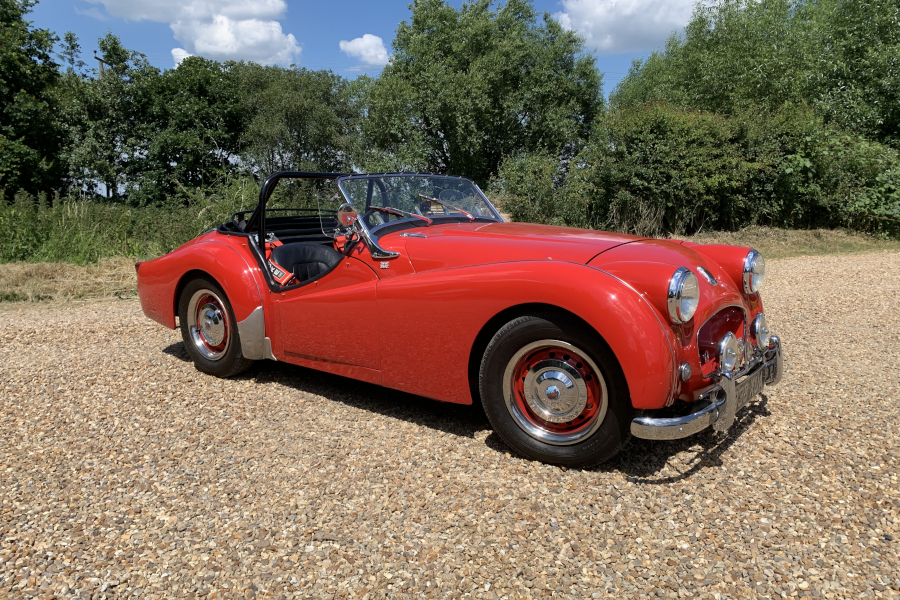The Triumph TR2 kicked off a four-decade legacy of iconic British sports cars. We get behind the wheel
Words and images: Paul Wager With thanks to: TRGB
Triumph’s TR line of sports cars would last the company through four decades, taking it from the Standard era to the Leyland takeover, the formation of BMH and then enduring the British Leyland years, finally bowing out in 1981 with the final TR7.
Where did it all begin though? Well just like so many iconic classic cars, it’s not as logical as you might think. A TR1 never made it to production, since a poor showing from the first TR prototype sparked a ‘back to the drawing board’ moment which meant that the first production Triumph sports car would bear the name TR2.
Although a strong seller for Triumph and proof that the formula was a successful one, the TR2 would be produced only for three years until it was replaced by the TR3 in 1955. Outwardly similar in appearance the TR3 was heavily revised and would remain in production for seven years, clocking up a production total of 74,800 which massively outclassed the TR2’s total of 8636.
With much of the production exported – crucial in those early postwar years – it’s no surprise that TR2s on American roads outnumber British survivors by some three to one, with less than 500 currently listed by DVLA.
Thanks to Cambridgeshire Triumph specialists TRGB though, we found one and a particularly nice example it is too, giving a perfect opportunity to find out just where the TR legend came from.

The story behind the TR2 is one of those sagas which could only come from the British motor industry and is both tragic and hilarious in equal measure. The legend goes that Standard Triumph’s mercurial boss Sir John Black had seen the success MG was enjoying with its affordable sports cars and fancied a bit of the action.
Accordingly a prototype was worked up under the name 20TS, following MG practice by using running gear from the saloon car range – in this case, an unlikely mixture of Standard Eight chassis, Mayflower front suspension and the Vanguard’s four-cylinder engine.
It looked the part but when BRM racing driver Ken Richardson was asked to test it he declared it to be a death trap, reportedly commenting “Frankly, I think it’s the most bloody awful car I’ve ever driven.”
The canny Black then asked him to assist in improving it, which resulted in a brand new chassis with coil spring and wishbone front suspension. The result would be displayed in 1953 under the name TR2, with the proud marketing boast being a 100mph top speed thanks to the car’s 953kg weight and the 90bhp from the twin-carb 2-litre.
Lack of space in the original prototype had seen the bodywork widened and lengthened for the TR2, with the cutaway doors allowing more elbow room for wrestling with the wheel when pressing on and the spare wheel hidden inside a neat rear compartment.
The combination of simple construction and the rugged Standard engine made the TR2 a favourite, especially when combined with the £900 purchase price and it quickly established Triumph as a credible competitor for its Abingdon rival.
So how does the forgotten TR stack up today? At Classics World we’re used to hopping between machinery of wildly differing ages, from brand new EVs to pre-war cars, but in my experience anything manufactured before the late 1960s generally requires a moment for mental readjustment and the TR2 is no exception.

The age of the design is obvious as soon as you try to open the door: the car comes from an era when proper sports cars did without such frivolities as wind-up windows, using simple slot-in side screens instead, which in turn means no external door handles. Instead, there’s a looped cord inside the door which simply pulls the latch open and in you climb.
First surprise is that the TR2 isn’t the squeeze so many traditional classic sports cars are, with generous footwells combined with the lack of a roof and those low doors making it easy to jump aboard.
The first TR also predates the advent of seatbelts and just like a Series 1 Land Rover, the low body sides do make you ponder the likelihood of toppling out under hard cornering, but this example features reassuring four-point harnesses as well as a beefy roll bar.
From here on though, it’s all resolutely conventional including a key start which back in the age of separate starter buttons was a very modern touch. The 1991cc four-pot fires on the first go and although it’s far from exotic in its make-up still manages a sporting edge to its exhaust note.
The four-speed box – with the optional overdrive in this car – slots into the non-synchro first without protest and the hydraulically operated clutch is as easy to live with as a car manufactured 70 years later.
In fact, within just half a mile it becomes apparent that the TR2 is a car of contradictions: the vague steering and the jouncy ride from the short-travel rear suspension betray the car’s 70-year age, but the driving experience is in many ways surprisingly modern, from the eager throttle response to the easy gearshift and the confidence-inspiring brakes. Although on that last point, it’s worth mentioning that a peer through the front wheels reveals that this car enjoys a disc brake upgrade from the TR3.
The TR wouldn’t move to rack-and-pinion steering until the TR4 appeared in 1961 and at higher speeds the car will wander a little, although you soon get used to a gentle sawing motion at the big 17-inch wheel to keep it in check and modern radial tyres make a big difference too.
As you’d expect from an engine designed in the late ’40s, the Standard 2-litre is no high-rev screamer, but a sturdy slogger, majoring on torque and maxing out at 4500rpm. It’s here of course that the Ferguson tractor connection comes up, but like the old myth of the Porsche 924 using an LT van engine, it’s a misconception to assume the TR2 has a tractor engine.

The truth of the matter is that when Standard won a lucrative contract to develop and produce a new engine for UK-made Ferguson tractors, the firm decided to take advantage of the investment and develop a passenger car version in parallel.
The result is that although the Ferguson and Standard versions of the engine share the same basic wet-liner block they differ in detail and capacity, with the car engines eventually developed to produce 104bhp in the TR4A.
Meanwhile, the engine was also supplied to Morgan, despite the little Malvern manufacturer being a rival for the TRs and having rebuffed Black’s takeover offer in 1950.
In practice, the tractor jibes are long forgotten when you get a well-sorted TR2 on a country road, where the car feels surprisingly brisk, helped by the overdrive providing what is effectively a six-speed box. Indeed, the TR had gained so much weight by the ’60s that the TR4 was no faster than the original TR2.
The short-travel rear suspension gives a bouncy ride, although the trade-off is a relative lack of body roll for a ’50s car and like so many sports cars of this vintage, you always feel like you’re really cracking on when a glance at the speedo generally reveals you’re well within the speed limit. Back in the day the limited rear wheel travel and rigid rear end were regarded as a handicap since it was easy under hard cornering to lift the inside rear wheel, the reduced contact patch then causing a sudden slide. Today, you’re unlikely to drive a cherished classic quite that hard, so it’s no more than an interesting footnote in TR history – and how many press photos of the Mk1 Golf GTI have you seen where the hot hatch is merrily cocking a wheel in the air?
Which, of course, means you can concentrate on the mechanics of driving in its purest form and it’s impossible to climb out of a TR2 without a big grin. Oddly, it’s also easier to drive in many ways than the later cars, especially the six-cylinder TR6 which can feel notably more intimidating to drive hard.
Certainly our brief outing in the TR2 showed just why Triumph’s sports car line became so successful for so long and as ever, I find myself comparing it with a Jaguar of the period. It may be a fraction of the value of an XK120 but the TR2 offers the same 1950s sports car experience and in truth, the same amount of fun. And that’s praise indeed.
This 1955 car is currently on offer at £22,495 and comes with some great upgrades including optional racing ‘Aero’ screens, disc brakes and a roll bar with four-point harnesses. Beautifully presented, very solid and in the same ownership since 2006, it’s a well-known example in club circles and comes with a huge history file.
As we discovered, it also drives exceptionally well and you’ll find more details here.











